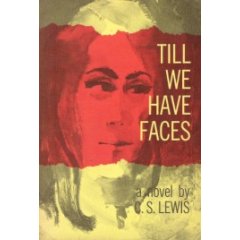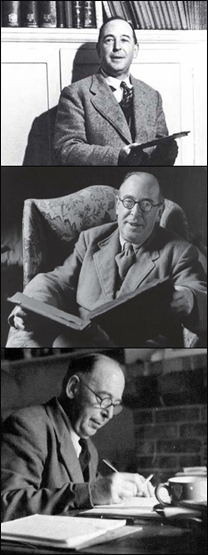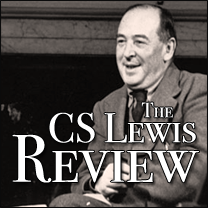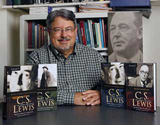
What’s Up with TILL WE HAVE FACES?
February 3rd, 2008 | Skip to comments
 A new friend asked me about resources and perspectives by which he might conduct a small group study of Lewis’s most elusive (and allusive) work, Till We Have Faces.
A new friend asked me about resources and perspectives by which he might conduct a small group study of Lewis’s most elusive (and allusive) work, Till We Have Faces.
That was a good provocation to explore it here. Dr. Peter Schakel’s earlier book was once the only starting point for reflective conversation, a time when few commentaries or any books about TWHF were available to Lewis readers. We owe him a great deal.
It deserves continued re-reading today, even if strikes one now as possibly a bit too overcommitted to reading Lewis’s own favorite work a bit too “outside-in”–focused on looking at Lewis’s attempt at resolving the tension between reason and imagination in his life and work. It is that, but also more, and many would argue that it is to be experienced primarily as an “inside-out” roller-coaster ride of looking along Orual’s experience, which was Lewis’s own.
If I were to capsule my own reading and teaching experience of TWHF it would be thus:
Tlll We Have Faces–heavily motivated by Lewis’s longtime interest in the cupid/psyche myth, but now influenced by and filtered through his courtship and marriage to Joy Davidman and mature Christian faith, and interwoven with several complementary writing projects of the roughly same period (Surprised by Joy; The Four Loves; An Experiment in Criticism)–represents a nuanced spiritual conversion story vaguely autobiographical but also comprising the singular narrative of every journey from bondage to freedom, from cavelight to sunshine, both painful and telling, demanding and piercing. It is daring, experimental, and unlike anything before or after it in Lewis’s published work.
Lewis intends its world, like Narnia’s, to stand on its own, offering no convenient Wardrobe entry point, demanding of its reader the patient, slow, respectful invasion by which he or she willingly becomes incarnate, submerged in a strange and forbidding new world where all the usual modern and familiar Lewisian signposts are absent; where one must learn page by page, monologue by soliloquy, what is happening, to whom, and what the “culture” of Glome is like, much in the fashion of Lewis’s famous, “Meditation in a Toolshed” essay.
In this manner, the reader experiences firsthand the incremental and gestalt-like appearance of truth, wisdom, and, eventually, revelation. But only by dying to self. “Die before you die,” is the central, most important recognition in the work. Lewis forces the reader to accept this principle even to get to the work’s last pages. Thus, TWHF demands–and rewards–multiple readings. “For him who eyes to see and ears to hear,” that is the motive and the message.
The Four Loves’ treatment of “devouring love” must be seen as a crucial backdrop (not to mention the path to Sehnsucht in Surprised by Joy), noting both the fact of its composition in roughly the same period but also their commonalities of theme. This is a characteristic of Lewis–to produce “duets,” to have a prose version of fictional text to accompany each other in time (e.g., think of Problem of Pain and Great Divorce with Screwtape; Preface to Paradise Lost and Perelandra; Abolition of Man with That Hideous Strength; Miracles and Narnia).
Paradise Lost and Perelandra; Abolition of Man with That Hideous Strength; Miracles and Narnia).
 I would recommend you read Doris Myer’s book, Bareface (U of Missouri P, 2004), as well as the essay on TWHF by Karen Rowe in my 4 vol. reference set, C. S. Lewis: Life, Works, and Legacy (Praeger, 2007). And nobody should read Lewis without consulting (and internalizing) his principles of readership in An Experiment in Criticism. Go here for a summary of that sparkling work.
I would recommend you read Doris Myer’s book, Bareface (U of Missouri P, 2004), as well as the essay on TWHF by Karen Rowe in my 4 vol. reference set, C. S. Lewis: Life, Works, and Legacy (Praeger, 2007). And nobody should read Lewis without consulting (and internalizing) his principles of readership in An Experiment in Criticism. Go here for a summary of that sparkling work.
For “book club” advice for a small group study, consult my study notes.




I took a college course on CSL at ORU in Tulsa. I remember we had a woman from Tulsa do a session on Till We Have Faces. I can’t remember her name (and those class notes aren’t readily accessible), but I think she had written a PhD dissertation on TWHF. It is a fascinating book. The scene of Orual before the gods (where the title comes from) is a profound picture of humility, dying to self, being “real” before God. Thanks for calling attention to it. I’ll have to re-read it soon.
Comment by John — 8 February 2008 @ 5:32 PM
HI… found your site via Don King of Montreat College.
I’m going to be reading ‘Till We Have Faces with a high
school ( homeschooled)literature class. I’m looking for
any resources or ideas. This blog helped. Thanks.
Bonnie Buckingham
Charlotte
Comment by Bonnie Buckingham — 1 April 2008 @ 5:09 PM
Bonnie,
Thanks for visiting my site via Don King.
Please see this “book club” document for some notes on discussion you might be able to use: http://www.pseudobook.com/cslewis/?page_id=116
Also, I recommend downloading and listening to this lecture by Peter Kreeft:
http://www.peterkreeft.com/audio/16_cslewis-till-we-have-faces.htm
There is a good essay on TWHF in my 4 volume encyclopedia set which you might find in the UNC-Chapel Hill libraries or some more local to Charlotte:
http://www.pseudobook.com/cslewis/?p=57
Best,
Bruce
Comment by Bruce Edwards — 2 April 2008 @ 4:17 AM